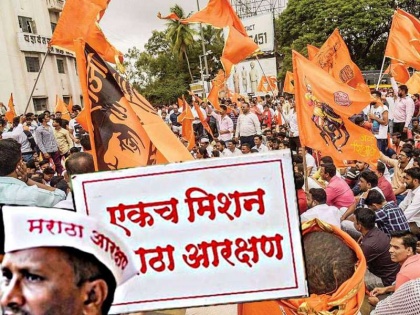Author Vishwas Patil presents compelling historical data on Marathas as Kunbi Marathas amid Jarange Patil's hunger strike
By Lokmat English Desk | Published: October 30, 2023 01:07 PM2023-10-30T13:07:44+5:302023-10-30T13:26:19+5:30
Protests over reservation demands continue to escalate in various parts of the state, particularly gaining intensity in Beed Latur ...

Author Vishwas Patil presents compelling historical data on Marathas as Kunbi Marathas amid Jarange Patil's hunger strike
Protests over reservation demands continue to escalate in various parts of the state, particularly gaining intensity in Beed Latur district within the Marathwada region.
Amidst this, Vishwas Patil, a retired officer and novelist, has asserted that historical evidence supports the Maratha community's affiliation with the Kunbi caste. In a comprehensive post on X (formerly Twitter). Patil highlighted that British records include documentation of the Kunbi community, which further substantiates this connection.
“The British government recorded not only Kunbi-Marathas but also sonars, carpenters, Dhangars, Hetkaris, various sub-castes of Brahmins, Muslims, Jews, and more, in a completely scientific and non-discriminatory manner. Additionally, they conducted scientific, in-depth studies to determine the counts of women and men, married and unmarried individuals, providing definitive estimates,” Vishwas Patil wrote in Marathi on X.
" संपूर्ण महाराष्ट्रभरच्या लाखो कुणबी–मराठ्यांच्या अस्सल नोंदी, ब्रिटिश–इंडिया काळात झालेल्या शास्त्रशुद्ध, जातवार जनगणनेनुसार उपलब्ध !
— Vishwas patil (@AuthorVishwas) October 29, 2023
मुख्यमंत्री @mieknathshinde यांच्या एकट्या सातारा जिल्ह्यात 5 लाख 83 हजार कुणबी – मराठा रेकॉर्डवर ! "
— विश्वास पाटील
मी महाराष्ट्राच्या… pic.twitter.com/w6JRLzauWA
Vishwas Patil said that for the past few months, he has studied the subject in depth by visiting many offices, libraries, and government offices across Maharashtra, also in Delhi, Vaijapur, Hyderabad etc.
According to Vishwas Patil, Chief Minister Shinde was born in the Satara district, which also included the Sangli district during the British era. Even after excluding the talukas of Phaltan, Miraj, and Sangli at that time, 5,83,569 people were registered as Kunbi in that district during the census. The British government has not only maintained records of the Kunbi community in a single district across Maharashtra but in many places. They have recorded clear information about the Kunbi community, part of the Maratha community, known for their involvement in agriculture and animal husbandry, essentially professional peasants.
According to Vishwas Patil, the district-wise records provided below are sourced from the British-conducted census records of the Kunbi-Maratha community.
• Satara (including the present-day Sangli district, excluding three Sansthani talukas)—of the 583,569 Kunbis, 293,748 are women, and 289,821 are men.
• Ratnagiri (including today's Sindhudurga)—out of 203,406, 97,467 are males, and 105,939 are females.
• Nashik - Out of the total Kunbi population of 205,099, 104,057 are males, and 101,042 are females.
• Out of a total of 284,267 in Solapur, 185,273 are males, and 148,994 are females.
• Thane (excluding Jawhar Sansthan) - The district with the lowest Kunbi population is 15,367, with 7,828 males and 7,539 females.
• Kolhapur - Out of 299,871, 152,113 are males, and 147,758 are females.
• Ahmednagar - Out of 304,000, 153,963 are males, and 150,847 are females.
• Aurangabad (including Jalna) out of 288,825, 147,542 males and 141,283 females.
• Nagpur district-152,000 is a clear number of Kunbis and a separate number of Marathas is also given as 11,000.
• Bhandara-79000
• Chandrapur-95000,(Kunbi Malgujari of three hundred villages,,)
• Belgaum (Bombay Presidency) - Total Kunbi: 42,650. Additionally, a separate number of Marathas in Belgaum district has been estimated at around one lakh.
• Colaba (Raigad) - Out of 159,336, 79,349 are men and 79,987 are women.
• Pune: Total Kunbi records 4 lakh (According to the 1881 census, Pune district had a population of 900,621, with 846,781 being Hindus, among them four lakh were Kunbis. Additionally, there were 42,000 Muslims, 619 Jews, 78 Chinese, and 80 Sikh citizens in Pune district at that time.)
"सर्व #जाती, #धर्म व छोट्या-मोठ्या व्यवसायिकांचीही जनगणना जिल्हावारच नव्हे तर सब- डिव्हिजनच्या स्तरापर्यंत करणारा ब्रिटिश इंडिया काळातील जबरदस्त सर्वे ".
— Vishwas patil (@AuthorVishwas) October 30, 2023
— विश्वास पाटील
मी आधी म्हटल्याप्रमाणे 1881 मध्ये भारतामध्ये ब्रिटिशांनी पहिला #शास्त्रशुद्ध असा जनगणनेचा प्रयोग राबवला. याची… pic.twitter.com/pDy9vaHNkw
In another post shared by Vishwas Patil on X today, he mentioned that in 1881, the British conducted the first scientific census experiment in India. It was initiated by Lord Mayo in 1872. However, the first scientifically rigorous survey was carried out in 1881. All gazetteers were published around 1884, in which the British meticulously recorded the population, professions, as well as natural resources, crops, and other sources of income. This comprehensive data was essential for planning the history, culture, geography, and future of the country.
This British survey is not limited to district-level data but provides information down to the 'sub-division' level, which corresponds to what we call a province, Patil mentioned.
According to Vishwas Patil, the census data of the Maval sub-division in Pune district from 1881 are as follows:
- Muslims: 612
- Christians: 70
- Parsis: 70
- Jews: 50
- Brahmins: 2,885
- Kayastha Prabhus: 76
- Pathare Prabhu: 22
- Marwar Vani: 626
- Lingayats: 252
- Vaishya Vani: 42
- Agarwal: 5
- Kunbi: 32,115
- Mali: 579
- Chambhar: 1,237
- Kumbhar: 535
- Sonar: 489
- Lohar – 92
-Vanjari: 103
- Mahar: 8,948
- Mang: 436
- Gondhali: 23
This caste and religion-wise survey continued till 1931, as per Vishwas Patil.
Open in app